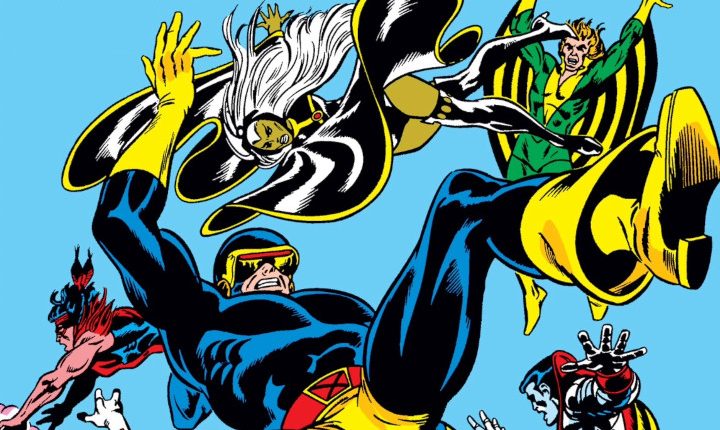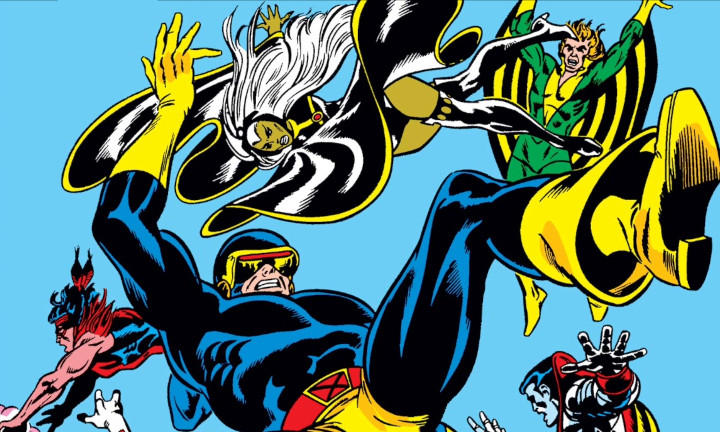
I’ve been on a journey through the formative years of the X-Men — a journey that began with the original run of X-Men, which was published from 1963 to 1970. The series was cancelled at that point, but characters like Charles Xavier and Hank McCoy still made plenty of appearances in other Marvel books between 1970 and 1975, A.K.A. “The Hidden Years.”
In 1975, there was something of a soft reboot for the series, which saw the exit of the original team to be replaced by a new one — a team that includes several members who should be familiar for anyone who watched the X-Men cartoon in the 1990s. This was the introduction of characters like Storm, Nightcrawler, and Colossus (and Wolverine, though his actual debut was jut a bit earlier in the pages of Incredible Hulk).
And this is where X-Men really starts cooking. After Giant-Size X-Men #1, which introduces these characters, a scrappy writer named Chris Claremont stepped in to finish the initial story that Len Wein started. After that, he would go on to create his own batch of stories for this new team. Claremont’s run would last for 17 years, and during that almost-two-decade period, he would bring the X-Men through some of their most important and most memorable adventures.
In case you couldn’t tell, I’ve been really looking forward to this part of the reading journey. I’ll talk about my thoughts on the stories in a bit. But first, I want to take a look at the actual physical product that is the Uncanny X-Men Vol. 1 omnibus, by Chris Claremont.
How is the quality of the physical book?
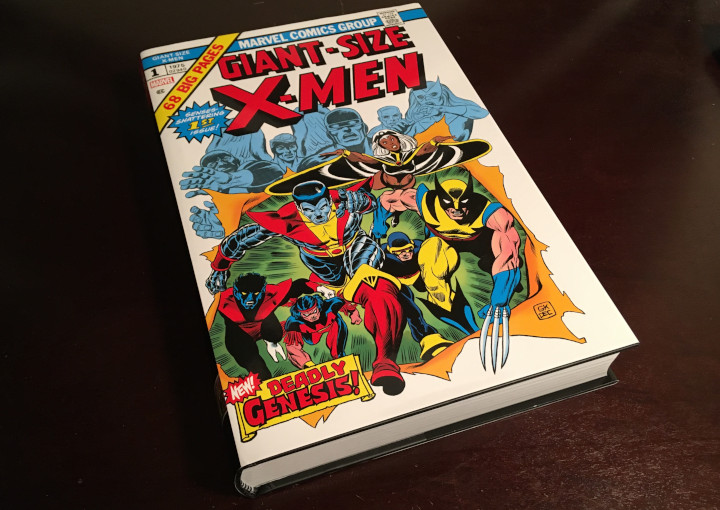
So, this collection is quite popular, and Marvel has reprinted it several times. My copy of this book was manufactured at Imak Offset in Istanbul, Turkey, sometime between July 9, 2021, and September 20, 2021. That’s important to know, because Marvel made some substantial changes to the book with this particular printing, and I’m not a fan of all of them.
First of all, let me talk about the change that bothers me the most. For a long time, Marvel was printing their Silver/Bronze Age omnibuses with a massive font on the spine of the books. With this printing, they shrunk it down substantially. In case you don’t think this sounds like a huge change, let me show you what Vol. 1 looks like on top of Vol. 4 (which is an older printing).
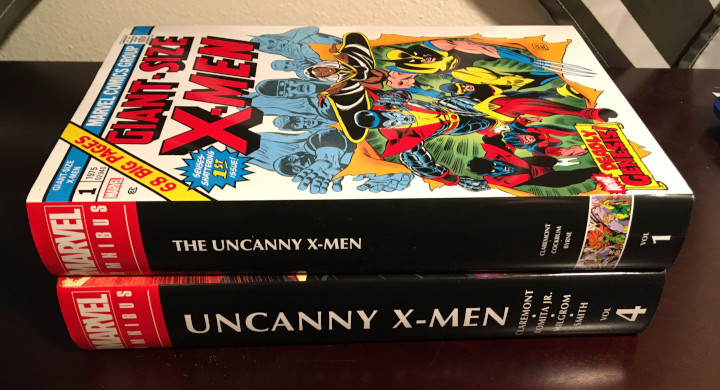
I currently have Vol. 1 and 2 with this new font size, and Vol. 3 and 4 with the old font size, so they don’t look consistent when they’re on the shelf together. And that really bothers me as a collector. Part of the joy of having this whole collection is looking at the spines on the bookshelf and seeing the full series in all its oversized glory.
That’s not the only change, but that’s the one that matters the most to me personally. One other detail to know about this dust jacket is that the edges, where it wraps around the spine of the book, have hard creases in them. I’m not sure why they did that with this particular book, but they did.
Another change is that there’s some color added to the book beneath the dust jacket. I believe the previous print run just had white text, and even older printings had a faux leather look with engraved silver text. This one has a full-color X-Men logo on the front, and even the tiny image on the spine is printed on the book itself (it shows a cropped version of the first page of Giant-Size X-Men #1).

I don’t like this as much as the original silver-on-leather version — I think it looks kind of low-rent– but I also prefer it to the white-on-black version. Even so, when this is sitting on the shelf, it has the dust jacket on it, so I only ever see the actual cover when I’m actually reading the book (I keep the dust jacket off when I read omnibuses).
The pages are also pretty thin, and this volume, at 848 pages, isn’t the monster that some of the other omnibuses are (Inferno, for example, is probably twice as thick, even though it’s 1,240 pages). I’m tempted to say that older printings of this book are thicker, and that’s largely because of the paper quality. (Don’t let the “68 Big Pages” text on the cover throw you off; this is actually reprinting the cover of Giant-Size X-Men #1, which is just one of the many, many issues included in this book.)
The pages are pretty thin, though they do have a touch of gloss to them. There’s some minor bleedthrough in the white spaces, as you can see if you look closely at the image below.
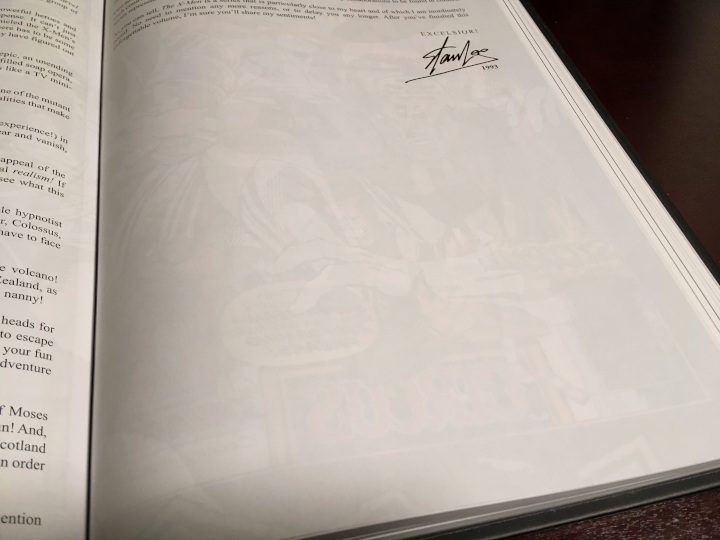
Also, I messed up the binding a little bit, even though I did take proper care to relax the spine before reading it. I’m not sure if this is a product of my own clumsiness, or if the binding is just kind of finnicky in general.

For me, it’s not a huge deal, because I know I’m going to read this book over and over again, and I’ll probably go back through it for reference while I’m reading later stories that have seedlings subtly planted here. It’s inevitable that it’s going to start wearing out at some point, and it looks like that time is sooner rather than later. We’ll see what it looks like in ten years…
What’s collected in this volume?

This volume collects Giant-Size X-Men #1, Uncanny X-Men #94-131 (it was called The X-Men when the comics were first released, but the series was renamed to Uncanny X-Men in the early 1980s), and X-Men Annual #3. If you want to see how this content is mapped, it looks like this:
- Giant-Size X-Men #1
- Uncanny X-Men #94-124
- X-Men Annual #3
- Uncanny X-Men #125-131
That takes us from 1975 to March of 1980. Yes, if you read this whole volume, you’ll wind up in the 1980s.
There’s a notable omission from this book, however. The A story from Giant-Size Fantastic Four #4 was not included in this collection, even though it was written by Claremont and features a pretty important character introduction (Jaime Madrox). And no, this story isn’t featured in Vol. 2, 3, or 4 either (I double checked for this review). It’s not a huge huge deal, I suppose, but it does feel like it belongs in this collection (I suspect that if Marvel ever creates a “Hidden Years” omnibus, this story would probably be added to that.)
I also think issue #131 is a really weird cutoff point. Longtime X-fans probably know why I say this already — this is in the middle of the Dark Phoenix Saga, which might very well be the most important X-Men story arc ever written. Well, I guess you could argue that this volume contains the setup for the Dark Phoenix Saga, and that the actual saga begins in the next volume. But to me, at least issues #129-131 seem essential to the saga. (I’ll point out that the covers for the corresponding Classic X-Men issues, as well as the Dark Phoenix Saga omnibus, seem to agree with me on this).
With fewer than 900 pages, this book had room to grow. There’s plenty of room to include everything up to issue #138, which would have added what? Maybe 120-140 pages? Well, I guess you’d probably want to also include Bizarre Adventures #27 and Phoenix: The Untold Story, but even if you did you’d still be under 1,200 pages for this omnibus — and keep in mind that the New Mutants Vol. 1 omnibus is 1,272 pages, so Marvel could have definitely gotten away with adding a few hundred pages to this.
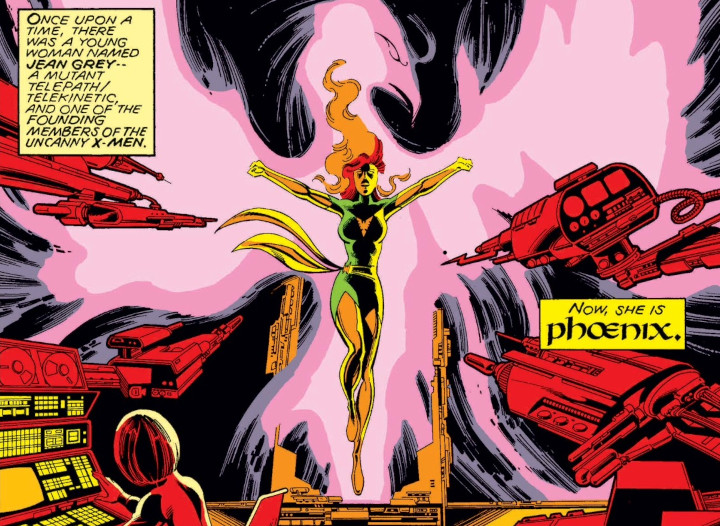
The cynical part of me wants to say that Marvel broke it up this way so they could sell the Dark Phoenix Saga omnibus to those of us willing to double dip. After all, it’s the only place to get the entire saga collected in oversize format in a single book.
But I’m rambling here. Let me get back to talking about what else is in this book, because the aforementioned comic issues are not all you’ll find inside it. Since this omnibus is essentially a re-collection of Marvel Masterworks volumes 1-4, there are introductions by Stan Lee and Chris Claremont interspersed throughout.
And also, the letters sections from the original comic issues are preserved here, which I really enjoy. You get to see what readers thought of the series back in the 1970s, and it’s fun to watch the editors at Marvel respond to criticism and try to patch over plot holes that are pointed out by fans.
Are the stories any good?

Before I share my thoughts, I should point out that not all of this material was brand-new to me. In fact, I’d read a majority of it before, though there’s a solid chunk in the middle of the book that I was reading for the first time. Plus, this is my first time reading these stories in their proper place in the reading order, which gave them some context that I wasn’t aware of in previous readings.
So how did I like it?
Admittedly, this volume starts out a little weak. You can sense that Claremont is still finding his confidence, and in the beginning he seems hesitant to transition away from the style of the X-Men comics that preceded this run. However, the series does start gaining momentum by the time we hit the Phoenix Saga (not to be confused with the Dark Phoenix Saga, which comes later). Famously, Jean Grey merges with a cosmic force called the Phoenix in issue #101, something that will permanently become part of her identity. (Well, nothing is ever really “permanent” in comics, and there are points in the series where Jean and Phoenix do act as completely separate entities. But all that comes later, and it’s not important for this particular run of comics.)
The stakes are greatly raised here, with the X-Men mythos growing in scope from a wham-boom-pow, villain-of-the-month series to an epic science-fiction soap opera that’s cosmic in scale. Part of what makes this work is that the characters are starting to change based on the things that happen to them — Jean’s merging with the Phoenix is just the first example, as you’ll later witness the strain on Jean and Scott’s relationship, Banshee losing his voice, Storm becoming more and more leaderlike with each issue, and so on. It gives you the sense that anything could happen, and suggests that you should cherish the time you have with these characters because they might be permanently altered by an event later on — or even taken off the team entirely (something that will be paid off gloriously once we reach the Dark Phoenix Saga).
With issue #108 comes an important change: John Byrne replaces Dave Cockrum as the penciler on the book. But Byrne lends more than his pencil to the series, as he’s also credited as a co-writer alongside Claremont. This collaboration elevates the book to new levels, and it almost feels like Claremont and Byrne were challenging each other to take bigger risks and tell bigger, more serialized stories. Once you hit issue #108, the momentum kicks in and the book becomes a lot harder to put down.
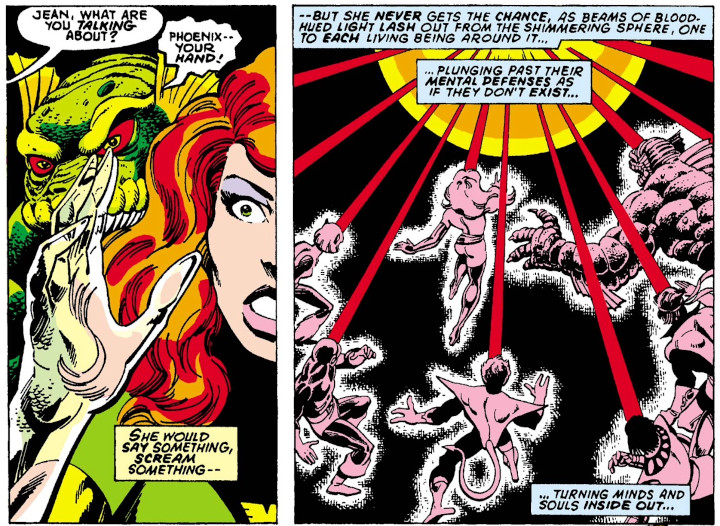
Claremont and Byrne will go on to deliver some of the most important stories in X-Men history (namely “The Dark Phoenix Saga” and “Days of Future Past” — though keep in mind this particular omnibus only collects the first section of “Dark Phoenix,” and “Days of Future Past” won’t show up until Vol. 2).
I should mention that I read this book alongside the B stories in the Classic X-Men omnibus, which makes it so much smoother. It’s a little bit of a hassle to leapfrog from omnibus to omnibus between every issue, but it does create a really nice rhythm. In between chaotic clashes with supervillains, you get some genuinely intimate moments that make these characters feel like human beings rather than action figures. And it’s these B stories that really start to endear you to the new X-Men.
That comes as a huge relief, if you ask me, because the X-Men spend so much time bickering with one another in the beginning portion of this book, and that can get a little grating if not spaced out by the gentler B stories.
Now, perhaps the greatest joy of reading this collection is seeing so many quintessential firsts. This features the first appearance of Nightcrawler, Colossus, and Storm, and the addition of Wolverine to the roster (Wolverine, remember, was introduced back in Incredible Hulk #180). Later on, we’ll see the first appearance of Moira MacTaggert, the first appearance of Alpha Flight, and eventually the first appearance of Kitty Pryde (as a dorky 13-year-old kid) and Dazzler. You’ll meet Emma Frost and the Hellfire Club, and you’ll even be introduced to Illyana Rasputin, but only briefly as a small child. You’ll see Jean Grey merge with the Phoenix, and Professor Xavier become romantically involved with Lilandra Neramani. You’ll witness Banshee leaving the X-Men after he loses his power.
I think I’ve made my point by now that a ton of stuff happens in this volume.
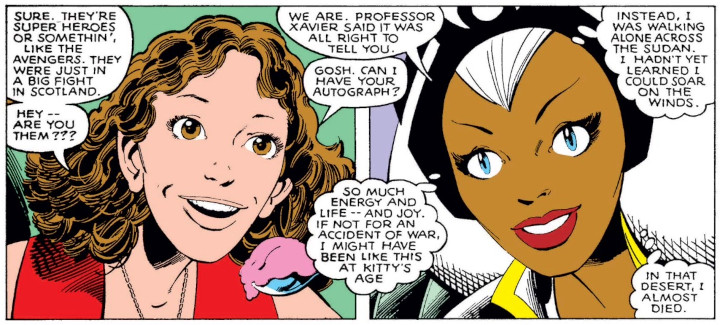
This book is for collectors who want to see (almost) all of Claremont’s 1970s X-Men work collected in one place. It’s for people who are willing to glean those tiny moments of setup from some stories that are pretty rough around the edges. It’s for readers who are interested in watching Claremont experiment with different things as he attempts to find his footing — long before he ever became a titan of the comic-book industry. And, it’s for people who want to witness the very beginning of John Byrne’s work on X-Men.
That said, it’s not for everyone. There are moments when I genuinely felt bored with it, but those are mostly consolidated toward the beginning of the book. The series builds momentum as it goes, and it really explodes once you hit the 1980s.
But that, of course, takes us to Uncanny X-Men Vol. 2 (by Chris Claremont), and that’s a story for another time.
